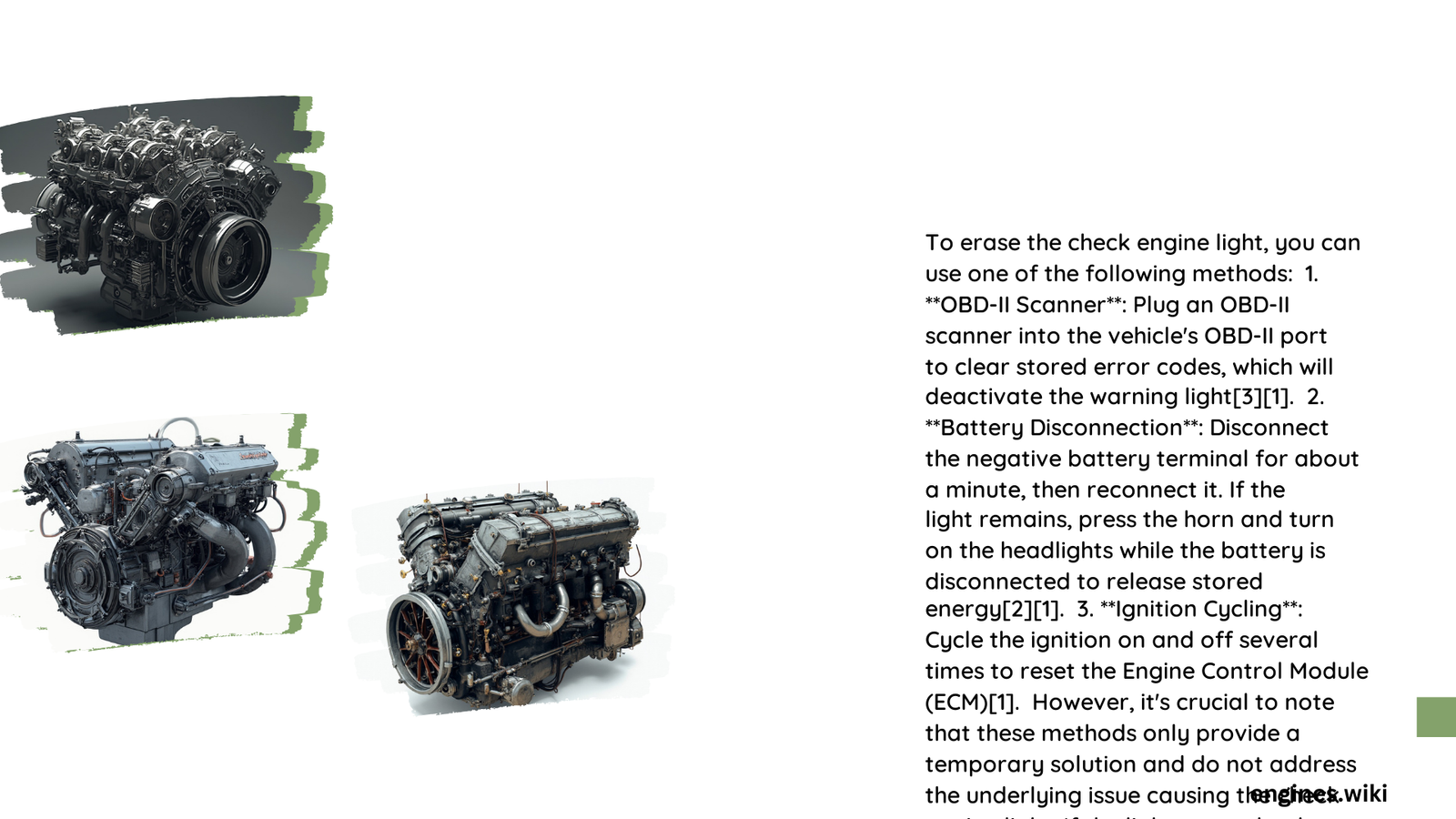The check engine light is a crucial indicator in your vehicle that signals potential issues with your car’s engine or emissions system. Erasing the check engine light involves resetting the vehicle’s onboard diagnostic system after addressing the underlying problem. This process can be done using specialized tools or through alternative methods, depending on the vehicle’s make and model.
What Are the Most Effective Methods to Erase Check Engine Light?
There are several methods to erase the check engine light, ranging from using specialized tools to simple DIY techniques. Here’s a comprehensive look at the most effective approaches:
1. Using an OBD-II Scanner
An OBD-II scanner is the most reliable and straightforward method for erasing the check engine light in vehicles manufactured after 1996. Here’s a step-by-step guide:
- Locate the OBD-II port (usually under the dashboard)
- Connect the scanner to the port
- Turn the key to the ‘on’ position (don’t start the engine)
- Read and note down the error codes
- Use the scanner to erase the fault codes
- Restart the vehicle to confirm the light is off
2. Battery Disconnection Method
This method can work for some vehicles but may not be effective for all:
- Locate the battery
- Disconnect the negative cable
- Wait for about 15 minutes
- Reconnect the battery
- Start the vehicle to check if the light is off
3. Ignition Cycling Technique
This simple method can sometimes reset the check engine light:
- Turn the ignition key to the ‘on’ position
- Wait a few seconds
- Turn it off
- Repeat this process 3-5 times
4. Driving and Natural Reset
If you’ve fixed the underlying issue, sometimes simply driving the vehicle for a few days can allow the system to reset itself naturally.
What Are the Common Reasons for Check Engine Light Activation?

Understanding the common reasons for check engine light activation can help in addressing the root cause before attempting to erase the light:
- Loose or faulty gas cap
- Malfunctioning oxygen sensor
- Catalytic converter issues
- Spark plug or ignition coil problems
- Mass airflow sensor malfunction
How Can You Prevent Check Engine Light from Reoccurring?
To prevent the check engine light from reoccurring after erasing it:
- Address the underlying issue promptly
- Perform regular maintenance
- Use high-quality parts for replacements
- Keep the fuel system clean
- Drive the vehicle regularly to allow systems to calibrate
What Are the Risks of Ignoring the Check Engine Light?
Ignoring the check engine light can lead to:
- Decreased fuel efficiency
- Increased emissions
- Potential engine damage
- Higher repair costs in the long run
- Failed emissions tests
How Often Should You Check and Erase the Check Engine Light?
It’s not recommended to frequently erase the check engine light without addressing the underlying issues. However, you should:
- Check the light during every start-up
- Address issues promptly when the light appears
- Perform a diagnostic scan at least once a year or as recommended by your vehicle’s manufacturer
What Tools Are Needed to Erase Check Engine Light?
Here’s a list of tools that can be useful for erasing the check engine light:
- OBD-II Scanner (basic or advanced models)
- Smartphone with OBD-II Bluetooth adapter and compatible app
- Wrench set (for battery disconnection method)
- Multimeter (for electrical system checks)
Can You Erase Check Engine Light Without Fixing the Problem?
While it’s possible to erase the check engine light without fixing the underlying problem, it’s not recommended:
- The light will likely reappear soon
- It can mask serious issues
- May lead to more severe damage if left unaddressed
- Could potentially void warranties
What Are the Legal Implications of Erasing Check Engine Light?
Erasing the check engine light without addressing the issue can have legal implications:
- May be considered tampering in some jurisdictions
- Can lead to failed emissions tests
- Potential fines or penalties in areas with strict emissions laws
How Does Erasing Check Engine Light Affect Vehicle Performance?
Erasing the check engine light itself doesn’t directly affect vehicle performance. However:
- It resets the vehicle’s diagnostic system
- May temporarily improve performance if the issue was causing limitations
- Allows the vehicle’s computer to relearn and recalibrate
Remember, erasing the check engine light should always be done after addressing the underlying issue to ensure your vehicle’s optimal performance and longevity.
